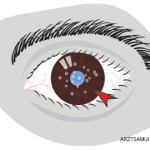NEW YORK (Reuters Health)—Rituximab may calm juvenile idiopathic arthritis (JIA)-associated uveitis and especially benefit patients who haven’t responded to other biologic treatments, a study from Italy suggests.
With its convenient dosing schedule, rituximab may be a new treatment option for patients with autoimmune diseases, especially for those who have not responded to tumor necrosis factor alpha (TNF-alpha) blockers, the authors, led by Dr. Elisabetta Miserocchi of the department of ophthalmology at the University Vita-Salute in Milan wrote in an article online Sept. 22 in the British Journal of Ophthalmology.
“This is an interesting study describing the long-term experience of this group of researchers in the management of sight-threatening uveitis associated with JIA. JIA-uveitis can be a serious disease and if untreated may lead to blindness,” Dr. John V. Forrester, ophthalmologist and emeritus professor at the University of Aberdeen, Scotland, told Reuters Health by email.
“A small subset of these patients fails to respond to anti-TNFs, which is why this paper is encouraging, particularly since it has been shown that the eye inflammation can be controlled long term by repeated infusions of the alternative biologic, rituximab, at regular intervals. This new treatment seems to be quite well tolerated and has been used in other conditions relatively safely,” said Dr. Forrester, who was not involved in the study.
Dr. Miserocchi and colleagues conducted a retrospective study of the case records of 15 eyes in eight patients who had severe, long-standing JIA-associated uveitis and inadequate uveitis control by one or more biologic agents, including at least one TNF blocker and/or abatacept. The patients ranged in age from 16 to 34 years, with a mean of 22.8. Six were female, and all were Caucasian.
The mean ocular disease duration was 17.7 years; the mean follow-up time on rituximab was 44.75 months; and the mean number of rituximab infusions received was 8.75 (range 6 to 12). All patients achieved complete uveitis control, but two patients discontinued rituximab due to its inefficacy in treating arthritis.
All patients received 1,000 mg infusions of rituximab on days one and 15 and every six months thereafter to maintain long-term quiescence and avoid uveitis recurrence. To reduce the risk of infusion reactions, they also received 100 mg of intravenous methylprednisolone, oral paracetamol and antihistamines before their infusions.
The researchers assessed the patients’ clinical responses to treatment, including uveitis activity decrease, visual acuity changes, related local and systemic corticosteroid and/or immunosuppressant reduction, and adverse events.
A positive clinical response, with improved intraocular inflammation and reduced anterior chamber cell reaction, was noticeable around the fourth month after the first infusion. At the final follow-up visit, all eight patients reached complete control of uveitis. In two patients, uveitis was controlled, but rituximab lacked efficacy in treating arthritis, so they were switched to golimumab.
All patients tolerated the drug well. None experienced side effects or rituximab-related complications during the follow up. By the end of follow up, systemic corticosteroids and immunosuppressants used with rituximab were discontinued in five patients.
Dr. Forrester said, “In severe cases, the standard treatment, methotrexate, may help the joint symptoms but does not control the eye inflammation. Recent studies have shown that the newer biologic agents, particularly therapies that block the inflammatory protein TNF-alpha, have revolutionized the management of these patients, and that treatment early in the course of the disease is probably best.”
Dr. Vinit B. Mahajan, assistant professor of ophthalmology and visual sciences at the University of Iowa in Iowa City, told Reuters Health by email, “There are many immunosuppressive medications available that were originally developed for immune diseases not affecting the eye. We don’t know which ones will also work for the eye and for how long, so these findings are exciting.”
“They are very important, since there are children all over the world who may not respond to conventional therapy,” added Dr. Mahajan, who was not involved in the study. “This study suggests an important alternative that may help prevent blindness and gives us an idea that in selected patients, rituximab can be effective for several years.”
The authors advised that their results should be interpreted with caution due to the study’s retrospective design, low number and heterogeneity of patients, and lack of a control group. Drs. Forrester and Mahajan agreed with the authors that further prospective randomized trials of rituximab are needed in larger groups of patients to better evaluate its efficacy, dosing regimen, and safety.
The corresponding author declined to comment.


